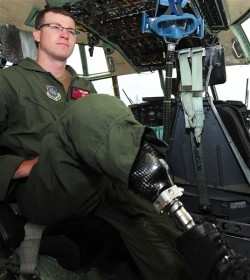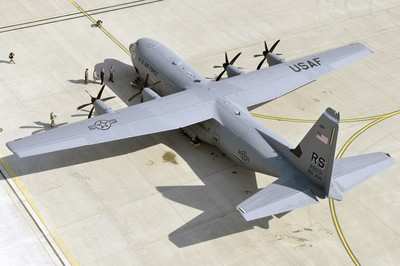Amputated Foot Not Stopping Airman From Flying, Or Other
Activities
 One year ago, Air Force Senior Airman Brian Petras (pictured,
right) was flying C-130 Hercules missions around the world.
Since then, the flight engineer was diagnosed with cancer,
underwent extensive surgery, recuperated, returned to all duties
except flying and passed his physical fitness test with no score
adjustments.
One year ago, Air Force Senior Airman Brian Petras (pictured,
right) was flying C-130 Hercules missions around the world.
Since then, the flight engineer was diagnosed with cancer,
underwent extensive surgery, recuperated, returned to all duties
except flying and passed his physical fitness test with no score
adjustments.
And he passed with just one foot. Petras, 24, has 700 deployed
flying hours from two deployments, and he's a cancer survivor.
Last summer, after icing his sore foot for a month and seeing no
improvement, he went to the doctor. "It started out as kind of like
a lump on my foot, like a swelling," he said, "and I just thought
it was a sprained muscle or something."
After a month and a half of tests and treatments, Petras learned
he had a malignant tumor and said that doctors would have to
amputate his right foot. "I was shocked," he said. "But since I ...
knew it was definitely going to happen, I just decided I could
either stay positive or feel sorry for myself. I've just been
trying to go on as normal as possible."
 Before his surgery, Petras enjoyed biking, running and
snowboarding. Since his surgery, he not only enjoys all of the same
activities, but also has become even more active. He recently rode
his bicycle 350 miles across Texas in six days, and later this
month he will begin a two-month, 4,000-mile coast-to-coast bike
ride from San Francisco to Virginia. The trip, organized by World
Team Sports, is called "The Face of America: Sea to Shining Sea
Ride." In the ride, Petras will join about a half dozen injured
servicemembers from each of the military branches, along with a few
civilians, to raise money for charities.
Before his surgery, Petras enjoyed biking, running and
snowboarding. Since his surgery, he not only enjoys all of the same
activities, but also has become even more active. He recently rode
his bicycle 350 miles across Texas in six days, and later this
month he will begin a two-month, 4,000-mile coast-to-coast bike
ride from San Francisco to Virginia. The trip, organized by World
Team Sports, is called "The Face of America: Sea to Shining Sea
Ride." In the ride, Petras will join about a half dozen injured
servicemembers from each of the military branches, along with a few
civilians, to raise money for charities.
Petras said his desire to returning to flying was a major factor
that motivated him to recover and return to work so quickly. "I
just enjoy flying," he said, "I can't stand sitting around. I like
traveling. I like just being on the flight, and I like the
challenge of it. "As of right now, I'm 95 percent back to normal,"
he continued. "There's really not much holding me back. I can run,
snowboard, ride a bike, pretty much do anything. I can do
everything I could before. I feel 100 percent confident I can go
back and do my job without any problem."
Despite his unshakable positive attitude, the road to recovery
hasn't been easy. "The first couple of months were pretty rough,"
he acknowledged. He healed for six weeks after the Aug. 24
amputation before he got a prosthetic leg. In the middle of
September, he started the first of four rounds of chemotherapy that
spanned three months. "It was one week on, then three weeks off to
recover," he explained.
He got his prosthetic leg shortly after his first round and
began rehabilitation between subsequent rounds. "That was pretty
rough," he admitted. "The chemo pretty much knocked me out. I had
almost no energy. I felt sick. I really couldn't do much. I could
barely take care of myself. Luckily, I was able to get a prosthetic
[leg] and walk around without crutches and still do certain things,
but I was still really tired."

File Photo
Petras went home for Christmas after his final chemotherapy
session, and in January he went to the Center for the Intrepid at
Brooke Army Medical Center in San Antonio. "It specializes in care
for amputees and burn victims," he said, "It's mostly guys coming
from Iraq and Afghanistan that are there. But they do a really good
job."
His time at the center gave him perspective, Petras said.
"Here's me with a below-the-knee amputation, rehabbing and getting
done in three months, and there are guys who've been there for
years," he said. "They're missing both of their legs, they're
missing [legs] above the knee, they're missing arms and hands, or
90 percent of their body is burned, and me coming in there is like
a scratch. It's not a big deal at all. "Those guys are very
inspiring," he continued. "Some of the guys, with the stuff they're
going through, have just as good an attitude as I have, so we all
kind of helped each other. To [the other patients], you're no
different; you don't get treated any different."
Petras said he was very pleased with the care he received at the
center. "The people who worked at the [Center for the Intrepid],
they're just really good at their jobs, from the physical
therapists, to the occupational therapist to the psychologist
there. Everybody cared about us and made sure we got the best
training possible or the best rehabilitation possible. They did a
really good job."
He added that he's especially grateful for the care he received
from John Wood, his recovery care coordinator, and Lauren Palmer,
his medical case manager. They were "two people who helped me out
immensely. Not even just medical stuff, but anything," he said. "I
don't like to consider myself handicapped. ... I feel normal," he
added.
The Bloomsbury, NJ, native said he continues to look to the
future. "The biggest thing I want to convey is that I don't see it
as a serious problem right now," he said. "I see it as a minor
inconvenience, and I want other people to treat me like that. I
think of this thing as a pair of glasses. For me, it's something
that takes me five extra minutes to get out of bed in the morning.
... The biggest challenge for me is taking a shower standing on one
leg. ... Some people have injuries that are not as visible as mine,
yet they're not even as mobile as me. I don't limp, I can run, I
can do whatever.

File Photo
"I don't want my accomplishments to be thought of as 'Brian the
amputee' did something," he added. "I don't like that. I want it to
just be 'Brian' did something. I want to be treated like it's not
that big of a deal. I don't feel handicapped. ... As far as I'm
concerned, I was ready to [return to flying] in January."
ANN salutes By Air Force Capt. Joseph Knable 19th Airlift
Wing
 ANN's Daily Aero-Term (04.14.24): Maximum Authorized Altitude
ANN's Daily Aero-Term (04.14.24): Maximum Authorized Altitude ANN's Daily Aero-Linx (04.14.24)
ANN's Daily Aero-Linx (04.14.24) Classic Aero-TV: 'We're Surviving'-- Kyle Franklin Describes Airshow Life 2013
Classic Aero-TV: 'We're Surviving'-- Kyle Franklin Describes Airshow Life 2013 Aero-News: Quote of the Day (04.14.24)
Aero-News: Quote of the Day (04.14.24) Airborne 04.09.24: SnF24!, Piper-DeltaHawk!, Fisher Update, Junkers
Airborne 04.09.24: SnF24!, Piper-DeltaHawk!, Fisher Update, Junkers






